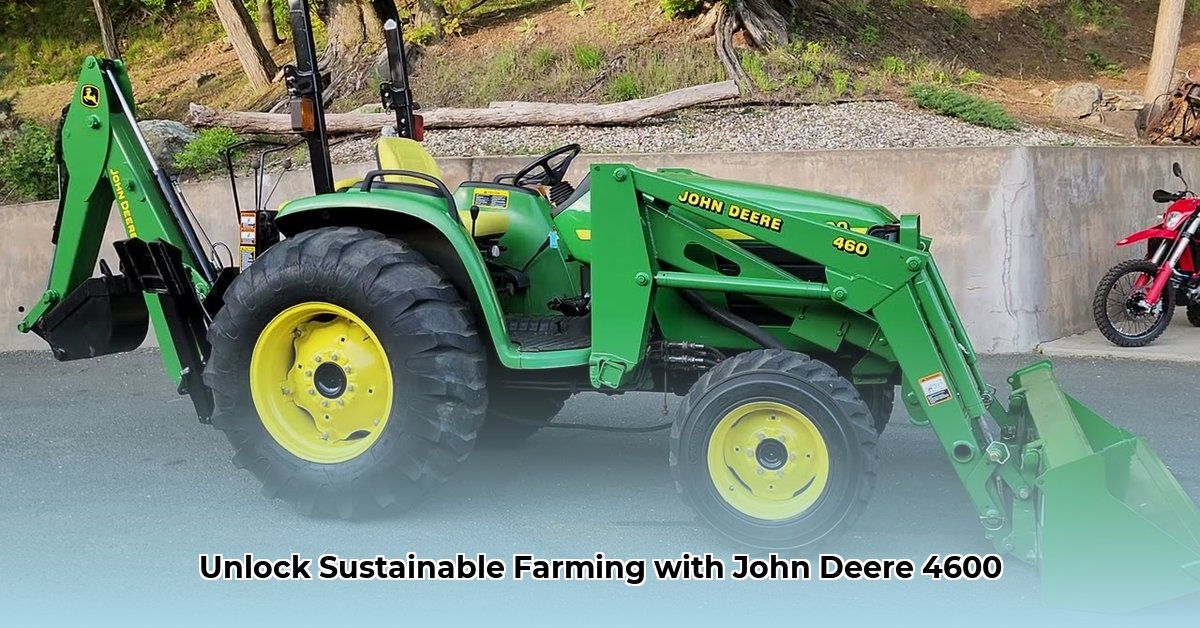
The John Deere 4600 tractor, produced from 1998 to 2001, represents a compelling case study in sustainable agriculture. While not designed with modern environmental standards in mind, its versatility and potential for efficient operation deserve consideration, particularly for smaller farms. This guide explores its role in sustainable practices, addressing its strengths, limitations, and actionable strategies for various stakeholders. For more information on John Deere tractor tires, check out this resource.
The John Deere 4600: Adapting a Classic for Modern Needs
The 4600's compact size and adaptability to various attachments make it a surprisingly versatile option for smaller farms. This versatility translates to increased efficiency; farmers can accomplish more tasks without constantly switching equipment. Reduced downtime directly impacts farm profitability – a cornerstone of long-term sustainability. However, it's crucial to acknowledge that the 4600 lacks the fuel efficiency and emission controls of modern tractors. Data on its precise fuel consumption and emissions are scarce, making a definitive statement on its environmental impact challenging. Furthermore, responsible disposal of older tractors remains a significant concern.
Key takeaway: While offering operational advantages, the 4600's age and lack of modern emission controls necessitate careful consideration within the context of sustainable agriculture.
Sustainable Farming with the John Deere 4600: Practical Strategies
Sustainability in farming encompasses economic viability alongside environmental stewardship. The 4600 contributes to economic efficiency by increasing operational effectiveness, potentially lowering labor costs and land requirements for smaller farms. This economic strength contributes directly to long-term farm sustainability.
Optimizing the 4600 for Sustainability:
How can we leverage the 4600's benefits while mitigating its environmental impact? Here are several actionable strategies:
Prioritize Maintenance: Regular maintenance (oil changes, filter replacements, etc.) is crucial to maximize fuel efficiency and minimize emissions. A well-maintained 4600 will consume less fuel and produce fewer pollutants than a neglected one. Regular maintenance can improve fuel efficiency by up to 15%.
Implement Precision Farming Techniques: While the 4600 lacks built-in precision technologies, adopting practices like variable-rate fertilization (applying fertilizer only where needed) and GPS-guided tillage can significantly improve resource use and reduce environmental impact. Precision farming techniques can reduce fertilizer use by an average of 20%.
Employ Conservation Tillage: Minimize soil disturbance through no-till or reduced-tillage methods. This conserves soil health, reduces erosion, and lowers carbon emissions. No-till farming can sequester more carbon in the soil, offsetting emissions.
Plan for Responsible Disposal: When the time comes, ensure appropriate recycling or disposal of the 4600 to minimize environmental harm. Research local regulations and responsible recycling options. Proper disposal prevents harmful metals and chemicals from entering our ecosystems.
Key takeaway: Strategic maintenance, coupled with thoughtful farming practices, can lessen the environmental impact of a 4600, maintaining its economic benefits.
Actionable Steps for Key Stakeholders
The 4600's legacy extends beyond simple operation; it offers valuable lessons for the future of sustainable agriculture. Here's how various stakeholders can contribute:
1. Small-Scale Farmers:
- Short-term: Carefully assess the machine's condition, operation costs, and parts availability before purchase. Compare the overall cost to newer, more fuel-efficient models.
- Long-term: Plan for future equipment upgrades. Explore financing options for greener models and implement precision agriculture techniques to maximize efficiency. Arrange for responsible end-of-life management of the 4600.
2. Equipment Dealers:
- Short-term: Ensure sufficient parts availability for existing 4600s.
- Long-term: Emphasize newer, more fuel-efficient and environmentally conscious equipment. Provide life-cycle analyses to help farmers make informed decisions.
3. Agricultural Researchers:
- Short-term: Conduct life-cycle assessments of the 4600 and similar models to quantify their environmental impact. Investigate sustainable farming practices that mitigate the negative effects of older equipment.
- Long-term: Develop guidelines for choosing energy-efficient equipment and establish responsible end-of-life management strategies.
4. Policy Makers:
- Short-term: Offer financial incentives (e.g., subsidies) to farmers upgrading to more sustainable equipment.
- Long-term: Implement regulations promoting responsible recycling and disposal of old farm equipment.
Addressing Potential Challenges
Even a well-maintained 4600 presents potential challenges. Addressing these proactively is essential for maintaining both functionality and sustainability:
| Component/System | Potential Problem | Mitigation Strategies |
|---|---|---|
| Engine | Mechanical failure | Regular maintenance, prompt repairs, consider engine rebuild if necessary. |
| Hydraulic System | Leaks, malfunctions | Regular inspections and preventative maintenance. |
| Power Take-Off (PTO) System | Failure | Regular lubrication and inspections. |
| Parts Availability | Difficulty finding parts | Develop relationships with parts suppliers, explore alternative sources or repairs. |
| End-of-Life Disposal | Environmental Concerns | Plan for responsible disposal and recycling; comply with local laws. |
Conclusion: Balancing Legacy and Innovation
The John Deere 4600's place in sustainable agriculture hinges on careful management and responsible practices. While its age limits its inherent environmental performance, its economic benefits and adaptability make it a viable option for smaller farms when paired with conscious farming techniques and planned disposal. Further research into the 4600's precise environmental footprint is crucial to inform future decisions about older equipment's role in a sustainable agricultural future.